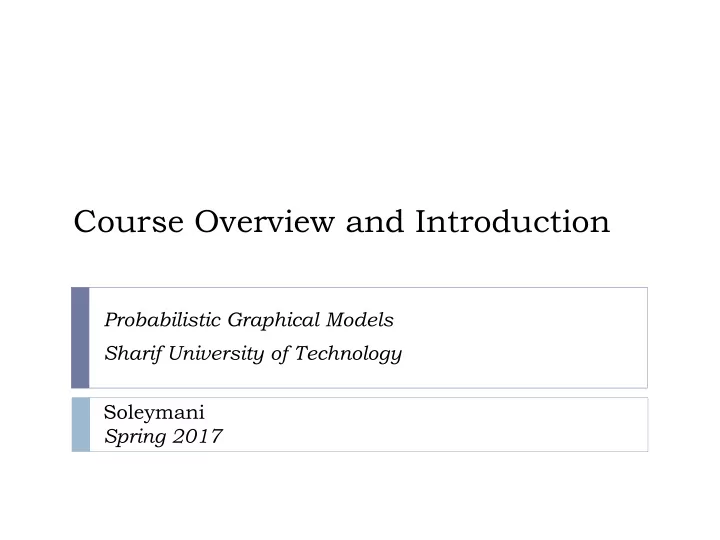

Course Overview and Introduction Probabilistic Graphical Models Sharif University of Technology Soleymani Spring 2017
Course info Instructor: Mahdieh Soleymani Email: soleymani@sharif.edu Website: http://ce.sharif.edu/cources/95-96/2/ce768-1 Lectures: Sun-Tue (13:30-15:00) , Room 202 Teacher assistants: Maryam Ramezani Amirhossein Akbarnejad Seyed Ali Osia Seyed Mohammad Chavosian 2
Text book D. Koller and N. Friedman, “ Probabilistic Graphical Models: Principles and Techniques ” , MIT Press, 2009. M.I. Jordan, “ An Introduction to Probabilistic Graphical Models ” , Preprint . Other C.M. Bishop, “ Pattern Recognition and Machine Learning ” , Springer, 2006. Chapters 8-11,13. K.P. Murphy, “ Machine Learning:A Probabilistic Perspective ” , MIT Press, 2012. 3
Evaluation policy Mid-term: 25% Final: 35% Home works & course works: 40% 4
Why using probabilistic models? Partial knowledge of the state of the world Noisy or incomplete observations We may not know or cover all the involved phenomena in our model Partial knowledge can cause the world seems to be stochastic To deal with partial knowledge and/or stochastic worlds we need reasoning under uncertainty 5
Why using a graph for representation? Intuitively appealing interface by which we can models highly interacting sets of variables It allows us to design efficient general purpose inference algorithms 6
Probability review Marginal probabilities 𝑄 𝑌 = 𝑧 𝑄(𝑌, 𝑍 = 𝑧) Conditional probabilities 𝑄(𝑌,𝑍) 𝑄 𝑌|𝑍 = 𝑄(𝑍) Bayes rule: 𝑄 𝑍|𝑌 𝑄(𝑌) 𝑄 𝑌|𝑍 = 𝑄(𝑍) Chain rule: 𝑜 𝑄 𝑌 1 , … , 𝑌 𝑜 = 𝑗=1 𝑄(𝑌 𝑗 |𝑌 1 , … , 𝑌 𝑗−1 ) 7
Medical diagnosis example Representation 𝑒 1 𝑒 2 𝑒 3 𝑒 4 diseases Findings 𝑔 𝑔 𝑔 𝑔 𝑔 5 1 2 3 4 (symptoms & tests) 𝑄(𝑔 1 |𝑒 1 ) 𝑄(𝑔 2 |𝑒 1 , 𝑒 2 , 𝑒 3 ) 𝑄(𝑔 3 |𝑒 3 ) … 8
PGMs as a framework General-purpose framework for representing uncertain knowledge and learning and inference in uncertain conditions . A graph-based representation as the basis of encoding a complex distribution compactly allows declarative representation (with clear semantics) of the probabilistic knowledge 9
PGMs as a framework Intuitive & compact data structure for representation Efficient reasoning using general-purpose algorithms Sparse parameterization (enables us to elicit or learn from data) 10
PGM: declarative representation Separation of knowledge and reasoning We need to specify our model for a specific application that represents our probabilistic knowledge There is a general suite of reasoning algorithms that can be used. 11
History Wright 1921, 1934 and before Bayesian networks are independently developed by Spiegelhalter and Lauritzen in statistics and Pearl in computer science in the late 1980 ’ s First applications (1990 ’ s): expert systems and information retrieval 12
PGMs: some application areas Machine Learning and computational statistics Computer vision: e.g., segmenting and denoising images Robotics: e.g., robot localization and mapping Natural Language Processing Speech recognition Information Retrieval AI: game playing, planning Computational Biology Networks: decoding messages (sent over a noisy channel) Medical diagnosis and prognosis … 13
Graphical models: directed & undirected Two kinds of graphical models: Directed: Bayesian Networks (BNs) Undirected: Markov Random Fields (MRFs) B A A B C C D D Causality relations Correlation of variables 14
Graphical models: directed & undirected [Pathfinder Project, 1992] 15
Representation, inference, and learning We will cover three aspects of the graphical models: Representation of probabilistic knowledge Inference algorithms on these models Using the data to acquire the distribution 16
Representation, inference, and learning Representation: When variables tends to interact directly with few other variables (local structure) Inference: answering queries using the model algorithms for answering questions/queries according to the model and/or based given observation. Learning of both the parameters and the structure of the graphical models 17
Medical diagnosis example Representation 𝑒 1 𝑒 2 𝑒 3 𝑒 4 diseases Findings 𝑔 𝑔 𝑔 𝑔 𝑔 5 1 2 3 4 (symptoms & tests) Inference: Given symptoms, what disease is likely? Eliciting or learning the required probabilities from the data 18
Representation: summary of advantages Representing large multivariate distributions directly and exhaustively is hopeless: The number of parameters is exponential in the number of random variables Inference can be exponential in the number of variables PGM representation Compact representation of the joint distribution Transparent We can combine expert knowledge and accumulated data to learn the model Effective for inference and learning 19
Graph structure Denotes conditional dependence structure between random variables One view: Graph represents a set of independencies Another view: Graph shows a skeleton for factorizing a joint distribution 20
Image denoising example 21 [Bishop]
Genetic pedigree example A0 B0 A B Bg Ag A1 B1 D C C0 D0 Cg Dg C1 D1 E E0 Eg E1 22
Plan in our course Fundamentals of Graphical Models: Representation Bayesian Network Markov Random Fields Exact inference Basics of learning Case studies: Popular graphical models Multivariate Gaussian Models FA, PPCA HMM, CRF, Kalman filter Approximate inference Variational methods Monte Carlo algorithms 23
Recommend
More recommend